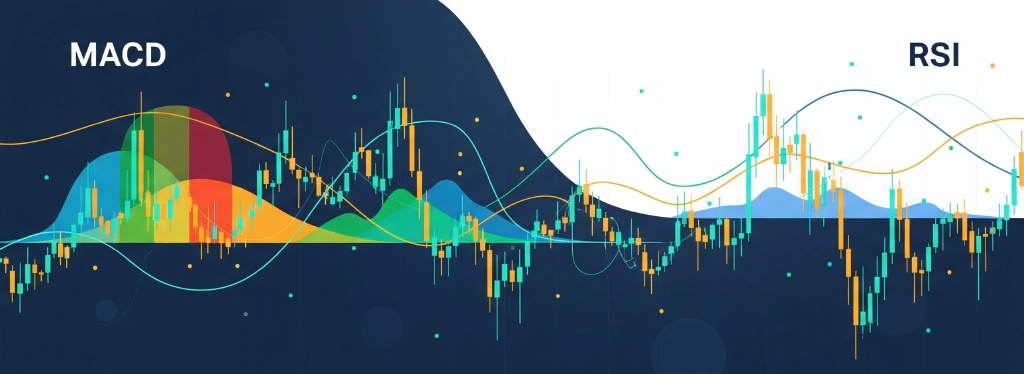
Complete comparison of MACD and RSI indicators. Learn when to use each, their strengths, weaknesses, and which is better for your trading style.
MACD vs RSI: The Ultimate Comparison
Both MACD and RSI are popular trading indicators, but they serve different purposes. This comparison will help you choose the right tool for your trading strategy.
Quick Comparison Table
| Feature | MACD | RSI |
|---|---|---|
| Type | Trend Following | Momentum Oscillator |
| Best For | Trend Identification | Overbought/Oversold |
| Timeframe | Medium to Long | All Timeframes |
| Signals | Crossovers, Divergence | Levels, Divergence |
| Lagging | Yes | Less |
Entry 1
Feature
Type
MACD
Trend Following
RSI
Momentum Oscillator
Entry 2
Feature
Best For
MACD
Trend Identification
RSI
Overbought/Oversold
Entry 3
Feature
Timeframe
MACD
Medium to Long
RSI
All Timeframes
Entry 4
Feature
Signals
MACD
Crossovers, Divergence
RSI
Levels, Divergence
Entry 5
Feature
Lagging
MACD
Yes
RSI
Less
MACD Strengths
1. Trend Following
- Excellent for identifying trend direction
- Great for trend continuation trades
- Works well in trending markets
2. Multiple Signals
- Signal Line Crossover: Entry/exit points
- Zero Line Cross: Trend confirmation
- Histogram: Momentum changes
3. Divergence Detection
- Spots potential reversals early
- Works on all timeframes
- High accuracy when combined with price action
RSI Strengths
1. Overbought/Oversold Levels
- Clear levels (30/70 or 20/80)
- Great for range-bound markets
- Immediate visual feedback
2. Faster Signals
- Less lagging than MACD
- Better for short-term trading
- Quick momentum shifts
3. Versatility
- Works on all timeframes
- Multiple strategies available
- Easy to understand
When to Use MACD
✅ Best For
- Trending markets
- Swing trading
- Daily/4H timeframes
- Trend confirmation
❌ Avoid When
- Range-bound markets
- Scalping (1-5 min)
- High volatility
- Need quick signals
When to Use RSI
✅ Best For
- Range-bound markets
- Scalping/day trading
- All timeframes
- Quick momentum reads
❌ Avoid When
- Strong trending markets
- Need trend direction
- Looking for exact entries
- Using alone
Real Trading Examples
MACD Example: EUR/USD Trend
- Setup: MACD signal line crossover above zero
- Entry: Buy when histogram turns positive
- Result: Caught 200-pip move
RSI Example: GBP/USD Range
- Setup: Price bouncing between support/resistance
- Entry: Buy at RSI 30, sell at RSI 70
- Result: Multiple profitable trades
Combining MACD and RSI
The Power Combo Strategy
- MACD: Determines trend direction
- RSI: Times entries within trend
- Entry: RSI pullback in MACD trend direction
Example Setup
- MACD: Above zero (uptrend)
- RSI: Drops to 40 (pullback)
- Action: Buy the dip
Which is Better?
For Beginners: RSI
- Easier to understand
- Clear overbought/oversold levels
- Less complex interpretation
For Experienced Traders: MACD
- More nuanced signals
- Better trend identification
- Multiple signal types
Best Choice: Both
- Use MACD for trend
- Use RSI for timing
- Combine for confirmation
Common Mistakes
MACD Mistakes
- Using in ranging markets
- Ignoring divergence
- Not waiting for confirmation
RSI Mistakes
- Fighting strong trends
- Only using 30/70 levels
- Not adjusting for timeframe
Conclusion
MACD and RSI complement each other perfectly. Use MACD for trend direction and RSI for precise timing. The combination provides a powerful trading edge when used correctly.
Share this article:
About the Author
T
TechnicalAnalyst
Expert trader and educator at RelicusRoad, sharing insights on advanced trading strategies and market analysis.
